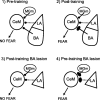Lesions of the basal amygdala block expression of conditioned fear but not extinction
- PMID: 16237172
- PMCID: PMC6725741
- DOI: 10.1523/JNEUROSCI.2600-05.2005
Lesions of the basal amygdala block expression of conditioned fear but not extinction
Abstract
Although the role of the amygdala in acquisition of conditioned fear is well established, there is debate concerning the intra-amygdala circuits involved. The lateral nucleus of the amygdala (LA) is thought to be an essential site of plasticity in fear conditioning. The LA has both direct and indirect [via the basal nuclei; basal amygdala (BA)] projections to the central nucleus (Ce) of the amygdala, an essential output for fear behaviors. Lesions of the LA or Ce prevent acquisition of conditioned freezing to a conditioned stimulus, but BA lesions do not, suggesting that the BA is not normally involved in fear conditioning. If true, posttraining BA lesions should also have no effect. Replicating previous studies, we found that rats given electrolytic BA lesions before training acquired conditioned fear normally. They also showed normal long-term retention and extinction of conditioned fear. Unexpectedly, BA lesions made after training completely blocked expression of conditioned fear. Despite this deficit, lesioned rats were able to learn a new tone-shock association. Thus, although the LA-Ce system is sufficient for fear acquisition in the absence of the BA, it is not sufficient when the BA is present, suggesting that the BA is an important site of plasticity in fear conditioning. The pattern of lesion deficits we observed (after but not before training) might be explained by homeostatic mechanisms that balance plasticity over multiple inputs, regulating the influence of the BA and LA onto Ce output neurons.
Figures





References
-
- Amorapanth P, LeDoux JE, Nader K (2000) Different lateral amygdala outputs mediate reactions and actions elicited by a fear-arousing stimulus. Nat Neurosci 3: 74-79. - PubMed
-
- Buzsaki G, Csicsvari J, Dragoi G, Harris K, Henze D, Hirase H (2002) Homeostatic maintenance of neuronal excitability by burst discharges in vivo. Cereb Cortex 12: 893-899. - PubMed
-
- Condé F, Maire-Lepoivre E, Audinat E, Crepel F (1995) Afferent connections of the medial frontal cortex of the rat. II. Cortical and subcortical afferents. J Comp Neurol 352: 567-593. - PubMed
Publication types
MeSH terms
Grants and funding
LinkOut - more resources
Full Text Sources
